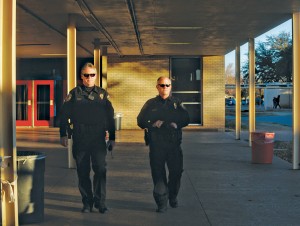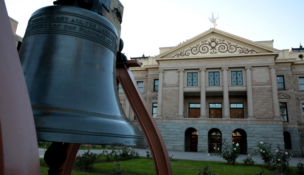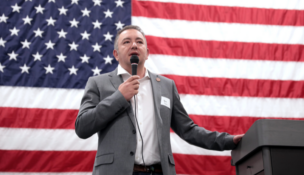Lawmaker proposing more money for School Resource Officers to help prevent shootings
Gary Grado//January 4, 2013//[read_meter]
Lawmaker proposing more money for School Resource Officers to help prevent shootings
Gary Grado//January 4, 2013//[read_meter]
 Arizona’s answer to the Newtown, Conn., massacre could be an infusion of guns next year on school campuses, either in the form of more cops, heat-packing principals or patrols of retired police officers and military veterans carrying concealed weapons.
Arizona’s answer to the Newtown, Conn., massacre could be an infusion of guns next year on school campuses, either in the form of more cops, heat-packing principals or patrols of retired police officers and military veterans carrying concealed weapons.
House Minority Leader Chad Campbell, a Phoenix Democrat, said he is going to introduce a comprehensive proposal next week to address the prevention of mass school shootings, part of which would include more funding for School Resource Officers or police officers who work in schools.
Campbell’s proposal is in line with the suggestion of the National Rifle Association of putting a cop in every school, but an Arizona- based Second Amendment group says there is a less expensive way of protecting children.
Campbell’s proposal came in response to a plan Attorney General Tom Horne announced Dec. 26 to allow one educator in each school to carry a gun, an idea Campbell said was horrible.
Campbell withheld details of his proposal, but said he would like to see money return to at least the “high water mark” of a few years ago for the School Safety Program, which had funding of $14.5 million in fiscal year 2008, the last year before the Arizona Department of Education and Legislature began slashing the program’s budget.
Charles Heller, a spokesman for the Arizona Citizens Defense League, a Second-Amendment advocacy group that has successfully lobbied for laws easing firearm restrictions, said the idea of putting armed police in schools is commendable, but it would cost too much.
“Government will always find a way to spend more government money,” Heller said.
He said a better idea would be to allow retired police officers and retired military veterans with concealed weapons to patrol schools.
“Not every single school every single minute has to have somebody there,” Heller said. “They can rove, they can be assigned a school, but it would cost very little. They could bring their own weapons.”
Heller said it would take a minor change in Arizona law to allow military veterans to carry a gun on school grounds, which ex-police are already allowed to do. Heller declined to say whether a bill for such a law is in the works.
He said his idea would cost no more than the price of name tags for the retired cops and veterans.
Rep.-elect Ethan Orr, a Tucson Republican, has an idea to pay for school resource officers through a matching funds formula whereby school districts would pay one-third of the cost, the state would pay a third, and local municipalities would pay the final third.
He said he has talked with the governor’s policy adviser about the issue, that Tucson Mayor Jonathan Rothschild is on board with the idea, and he is seeking feedback from law enforcement organizations before putting his proposal into bill form.
But he wants to make sure the program is sustainable. That involves either finding a way to allow school districts to take over the costs eventually, or finding a dedicated source for the state funding portion.
“It is worse if we fund the program and then a few years down the line the state can’t pay for it and it forces school districts to go bankrupt trying to fund these positions,” he said.
Campbell said the idea of increasing funding for School Resource Officers, or SROs, has the support of educators and there are plenty of places in the budget to find the money.
Campbell would like to see an SRO in every school, but said that is unrealistic. So increasing school safety will require a “fully funded comprehensive approach” that includes changes to policies on mental health care and providing schools with resources to conduct threat assessment and develop emergency plans.
“When you talk about risk of any kind, you can never eliminate risk, that’s impossible, but you can mitigate it, try to minimize the opportunity for it to happen,” Campbell said.
Until 2008, the School Safety Program, which funds the SROs, received $7.8 million from Proposition 301, a 2000 education ballot measure, and a $6.7 million appropriation from the general fund.
The cuts began in fiscal year 2009, when Horne, then superintendent of public instruction, took $442,761 and $1.5 million the next year to plug holes left by lump sum reductions to the Department of Education budget. The Legislature then ended the $6.7 million appropriation in 2011.
According to the Department of Education, there were 273 officers (both police and a few probation officers) in 279 schools under the program in fiscal year 2007.
There were 104 officers at 104 schools in fiscal year 2012.
Rob Katzaroff, vice president of the Arizona School Resource Officers Association, whose main purpose is for training, not lobbying, said there are roughly double that number of SROs in the state. The rest are funded through agreements between school districts and police departments.
Under the School Safety Program, which still receives the Prop. 301 money, school districts apply for the money. They have to justify school safety needs and present plans for a “law-related education program,” or classes taught by the officers, including how the officers will be used.
The Legislative School Safety Program Oversight Committee awards the money at the Department of Education’s recommendation. It took the committee only a few minutes in a June meeting to approve the awards.
Katzaroff said adding SROs and addressing mental health issues are where to start when it comes to preventing mass shootings, because most of the killers nationwide were suicidal.

















